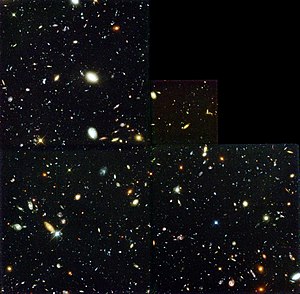I've seen many strange YEC arguments over the last 30 years, but this one, posted on a fundamentalist Christadelphian Facebook group, is difficult to top:
The record does NOT say that God made the two great lights and the stars directly in the expanse (KJV: firmament) of heaven. God intended them to be there (v14,15), but it first says God made them (v16), and then it says God set them in the expanse of heaven (v17). So they were moved from where they were made to where they were to do their work. (That was also true of Adam, later (Gen 2:7,8,15).)
This allows for God to have made the various sources of light relatively close to the earth where their light would reach it quickly (within hours, or even minutes - the sun itself is only about 8 light-minutes away). Having made them, he could then have moved the stars into their places in the expanse of the heavens. As one of the functions of the stars is to give light on the earth, their light that would reach the earth initially could continue to do so even while they were being moved, so there would be no interruption and we can still see it today, although the stars themselves are now very much farther away.The assertion is of course demonstrably untrue. The firmament in Genesis 1 as I've pointed out many times is a solid structure separating waters above from waters below. This fact rules out any attempt to link it with outer space. Just on Biblical grounds, the argument fails.
The scientific objections are equally overwhelming. Arguments such as that made by the Christadelphian fundamentalist fail to take into account the large scale size and structure of the universe. The claimant asserts that God could have placed the ' various sources of light' within a few light hours or light minutes of Earth, but this comment shows little understanding even of the size of the solar system, as it takes over 4 hours for sunlight to reach Neptune - putting stars close enough for their light to reach Earth within minutes would put them well within the orbit of Saturn.
Furthermore, the reference to stars ignores the fact that stars exist in galaxies. Even small galaxies such as the Small Magellanic Cloud are 7000 light years in diameter, while large galaxies such as the Andromega galaxy are over 200,000 light years in diameter. Trying to fit billions of galaxies that are thousands of light years in diameter around a sphere a few light days in diameter is simply impossible, as anyone trying to park hundreds of warships around a wading pool would realise.
Hubble Deep Field. This represents around 1/24,00,000 of the whole sky. Multiply this by 24 million, park it around a sphere
a few light days in diameter, and you will run out of room very, very quickly. Source
Other problems in the argument exist—such as the problems inherent in having active galactic nuclei, black holes, and neutron stars so close to Earth, or the fact that stretching out space so quickly to get 13 billion light years worth of expansion occurring within a few days would red shift light to invisibility, making the visible universe invisible—but frankly, when someone can't appreciate the impossibility of crowding the known universe just outside the solar system, this attempt to argue away the evidence for an ancient universe fails at the first hurdle.
The truly upsetting thing about such posts is not the lack of theological and scientific knowledge on display but the uncritical response of the audience, which betrays identical limitations and the same naked hostility towards scholarship.
While such groups represent the extreme fringe of our community, they do hint at a regrettable lapse from the thoroughly rational approach of the early Christadelphians. It's another reminder why sites such as this one are necessary in the light of such unrepentant obscurantism.
For those wanting an accessible overview of how we can determine how far away stars and galaxies are, this website comes highly recommended.
Other problems in the argument exist—such as the problems inherent in having active galactic nuclei, black holes, and neutron stars so close to Earth, or the fact that stretching out space so quickly to get 13 billion light years worth of expansion occurring within a few days would red shift light to invisibility, making the visible universe invisible—but frankly, when someone can't appreciate the impossibility of crowding the known universe just outside the solar system, this attempt to argue away the evidence for an ancient universe fails at the first hurdle.
The truly upsetting thing about such posts is not the lack of theological and scientific knowledge on display but the uncritical response of the audience, which betrays identical limitations and the same naked hostility towards scholarship.
While such groups represent the extreme fringe of our community, they do hint at a regrettable lapse from the thoroughly rational approach of the early Christadelphians. It's another reminder why sites such as this one are necessary in the light of such unrepentant obscurantism.
For those wanting an accessible overview of how we can determine how far away stars and galaxies are, this website comes highly recommended.
